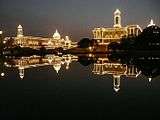Rajpath
Rajpath
राजपथ


Coordinates: 28°36′48″N 77°13′06″E / 28.613388°N 77.218397°E

Rajpath (meaning "King's Way") is a ceremonial boulevard in New Delhi, India, that runs from Rashtrapati Bhavan on Raisina Hill through Vijay Chowk and India Gate to National Stadium, Delhi. The avenue is lined on both sides by huge lawns, canals and rows of trees. Considered to be one of the most important roads in India, it is where the annual Republic Day parade takes place on 26 January. Janpath (meaning "People's Way") crosses the road. Rajpath runs in east-west direction. Roads from Connaught Place, the financial centre of Delhi, run into Rajpath from north.
After climbing Raisina Hill, Rajpath is flanked by the North and South Blocks of the Secretariat Building. Finally it ends at the gates of Rashtrapati Bhavan. At Vijay Chowk it crosses Sansad Marg, and the Parliament House of India can be seen to the right when coming from the India Gate.
It is also used for the funeral processions of key political leaders of India. The opening scene of the movie Gandhi starts at Rajpath.
History
The city plan of New Delhi (the area surrounding Rajpath) was made by the British architect Edwin Lutyens. Rajpath (then called King's Way or Kingsway by the British) was of central importance to the plan. Lutyens wanted a panoramic view of the city of Delhi from the Viceroy’s palace. The view from Raisina Hill runs unhindered across Rajpath and India Gate and is obstructed only by the National Stadium.
Most of the buildings surrounding Rajpath, were designed by Lutyens and Herbert Baker.
Landmarks
- The Rashtrapati Bhavan, the official residence of the President of India. It was the Viceroy's residence before India got its independence from Britain.
- North Block and South Block, also called the Secretariat Building. North Block houses the offices of Finance and Home ministries. South Block hosts External affairs and Defense ministries. Other important offices like some of the Prime Ministers Offices are also in the Secretariat Buildings.
- Vijay Chowk (Hindi for Victory Square) is a spacious plaza and the site of Beating the Retreat ceremony, which takes place on 29 January each year, which marks the end of Republic Day celebrations, in which Military Bands, Pipes and Drums Bands, Buglers and Trumpeters from various Army Regiments besides bands of the Navy and Air Force take part, with the President of India as the Chief Guest.[1]
- India Gate is India's war memorial arch in honour of those who died in the First World War and the Second Anglo-Afghan War. It is also India's memorial of the unknown soldier.
Gallery
 Vijay Chowk at Rajpath, with Secretariat Building in the background, New Delhi, the venue of the Beat Retreat ceremony
Vijay Chowk at Rajpath, with Secretariat Building in the background, New Delhi, the venue of the Beat Retreat ceremony North and South Block of the Secretariat Building illuminated
North and South Block of the Secretariat Building illuminated International Yoga Day, 2015 held on Rajpath
International Yoga Day, 2015 held on Rajpath Sansad Bhavan - Parliament of India as seen from the Rajpath
Sansad Bhavan - Parliament of India as seen from the Rajpath- North Block of the Secretariat Building seen from Rajpath
 South Block of the Secretariat Building seen from Rajpath
South Block of the Secretariat Building seen from Rajpath_01.jpg) Rashtrapati Bhavan seen from Rajpath
Rashtrapati Bhavan seen from Rajpath Indian Naval contingent marching on the Rajpath
Indian Naval contingent marching on the Rajpath
References
- ↑ "Curtain Raiser – Beating Retreat Ceremony 2011". Ministry of Defence. January 28, 2011.
External links
| Wikimedia Commons has media related to Rajpath. |